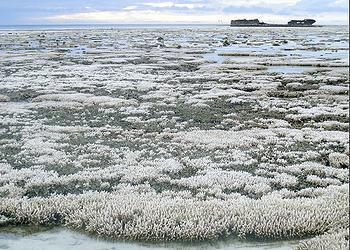GR: We certainly need to do something soon. This is the kind of large-scale conservation effort that we should have applied to all our ecosystems. But now, we must acknowledge that it is a treatment of symptoms not causes. This is a poor strategy. It’s not certain that we can save any reefs. Even with just the greenhouse gases we’ve already placed in the atmosphere, projections for increased ocean warming don’t look good for corals. Why not spend the money to buy back a few politicians from the fossil-fuel industry. If we could, we might be able to redirect fossil-fuel industry subsidies to research into atmospheric CO2 removal. This is where we need to spend our money now.

Coral bleaching on Australia’s Great Barrier Reef, Feb. 10, 2016 (Photo by Oregon State University)
“SYDNEY, Australia, March 12, 2017 (ENS) – Ninety percent of the world’s coral reefs are expected to disappear by 2050 due to climate change, pollution and poor fishing practices. Now, a unique philanthropic coalition has launched 50 Reefs, a plan to save the most critical reefs so once the climate stabilizes they can reseed the entire coral ecosystem.

Corals on the Mesoamerican Reef have experience widespread bleaching events in 1995, 1998, 2003, 2005, 2008, 2009 and 2010. Corozal, Belize, Dec. 2016 (Photo by Viv Lynch)
“The initiative, launched at The Economist World Ocean Summit in February, brings together ocean, climate and marine scientists as well as conservationists from around the world to develop a list of the 50 most critical coral reefs in need of protection.
“The idea is to identify 50 high priority coral reefs that have the best chance of surviving climate change and can then help in the recovery of coral reef ecosystems once global temperatures have stabilized.
“As the project unfolds through 2017, a panel of world leading scientists will oversee a process to prioritize reefs worldwide deploying a transparent ‘decision algorithm’ developed at The Centre for Excellence in Environmental Decisions at The University of Queensland.
“The datasets used, such as reef biodiversity, climate vulnerability, current health and reef connectivity, will be agreed upon by the independent panel of scientific experts drawn from some of the world’s leading organizations.
“To be announced in late 2017, the list is expected to represent a diverse portfolio of reefs to maximize returns for biodiversity, ecosystems and people.
“Funding of this global effort is led by Bloomberg Philanthropies with The Tiffany & Co. Foundation and The Paul G. Allen Family Foundation, who all aim to prevent the worst economic, social, and environmental impacts of the coral crisis.
“Bloomberg News founder and former New York Mayor Michael Bloomberg is now the UN Secretary-General’s Special Envoy for Cities and Climate Change. “When people think of climate change, they often think of extreme heat, severe storms, and raging wildfires,” he said. “But some of the most disastrous effects of climate change are out of sight – on the ocean floor.”
“In fact, without coral reefs, we could lose up to a quarter of the world’s marine biodiversity and hundreds of millions of the world’s poorest people would lose their primary source of food and livelihoods. We must not allow this to happen,” said Bloomberg.” –News Editor ENS (Continue reading: 50 Reefs: A Global Plan to Save Corals from Extinction | ENS.)

